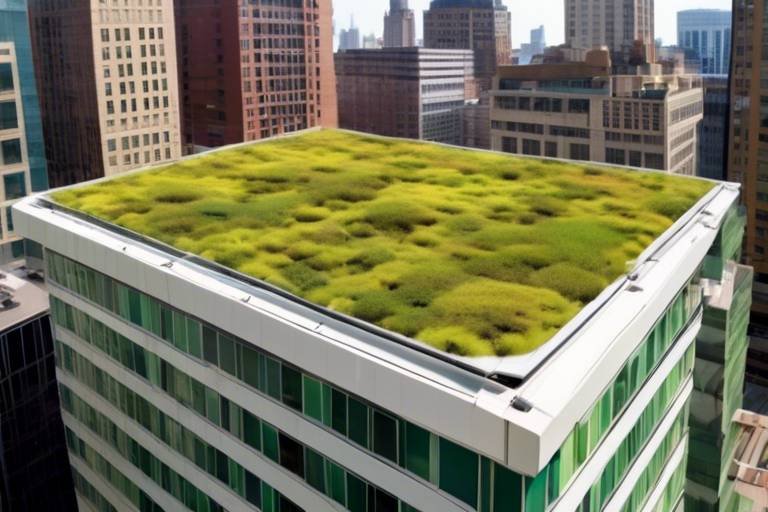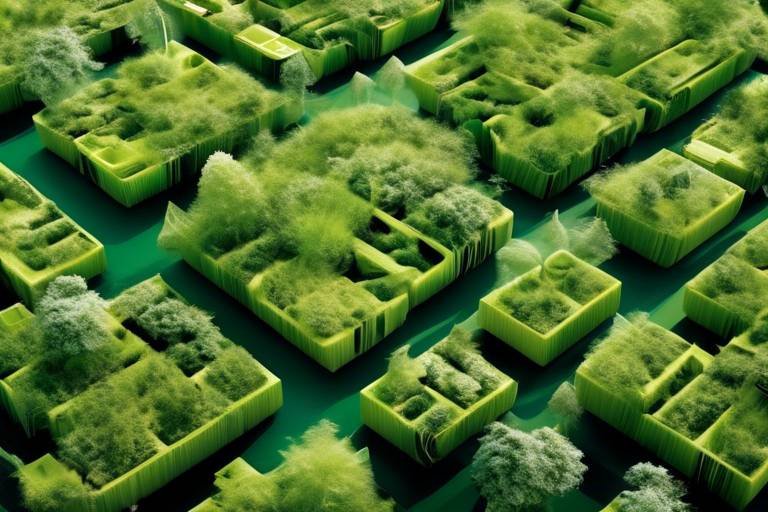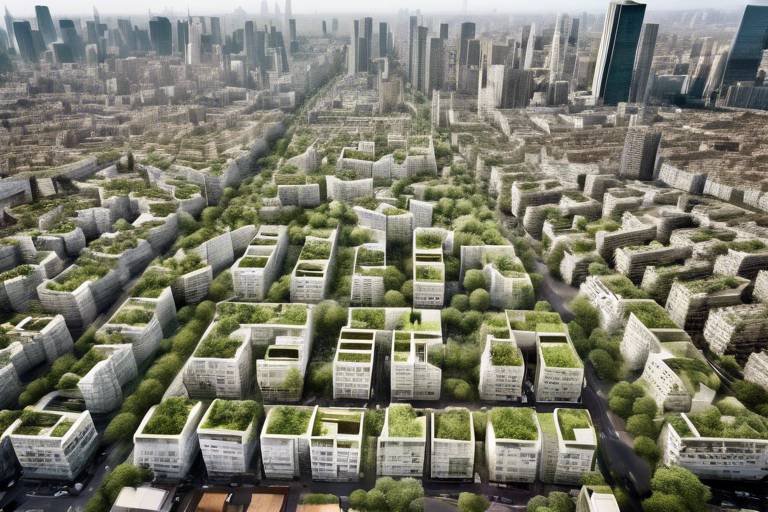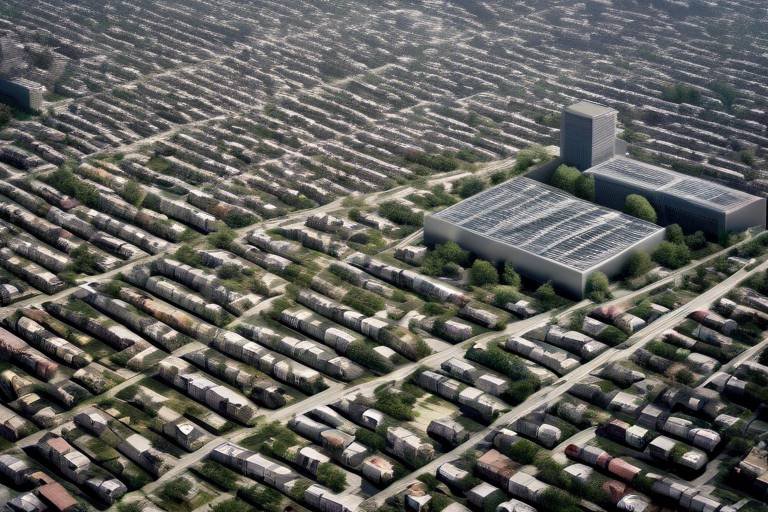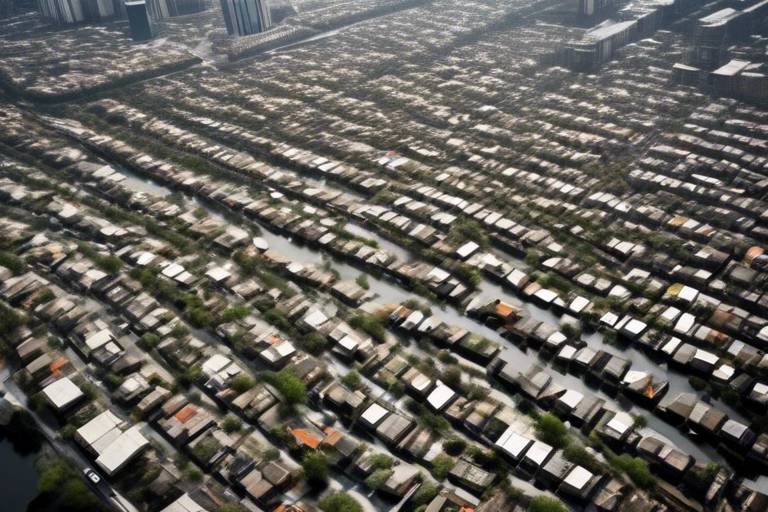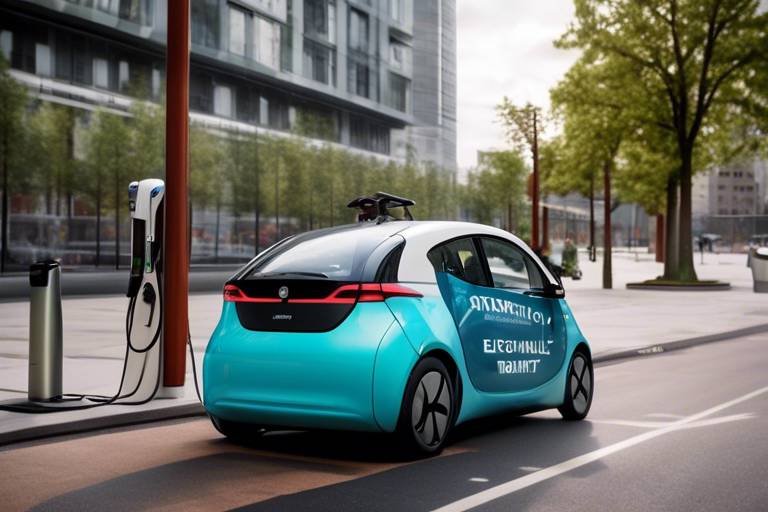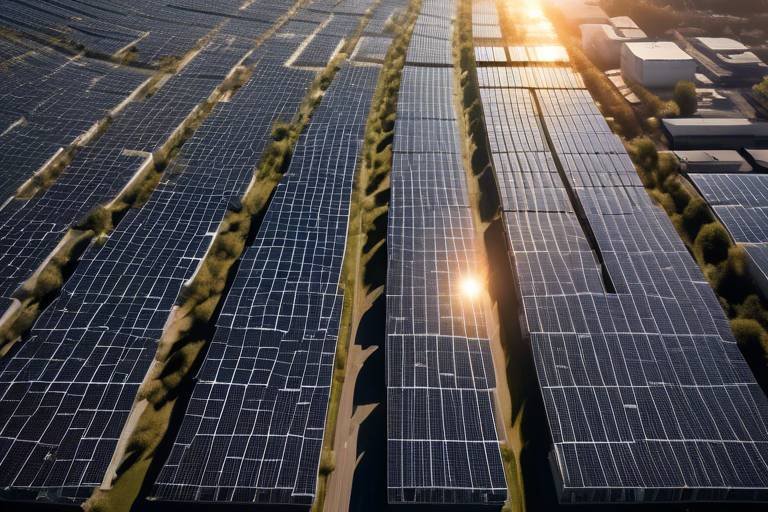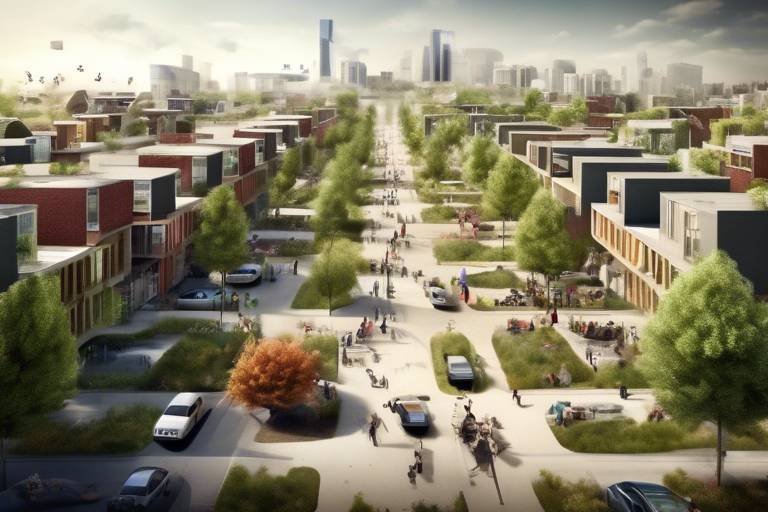The Role of Green Roofs in Urban Heat Island Mitigation
In today's rapidly urbanizing world, the phenomenon of urban heat islands (UHIs) has become a pressing concern. These are areas within cities that experience significantly higher temperatures than their rural counterparts, primarily due to human activities, concrete structures, and limited vegetation. Green roofs have emerged as a powerful solution to combat this issue, providing not only a way to mitigate heat but also enhancing the overall urban environment. Imagine walking through a city where the air feels cooler, the noise is less overwhelming, and the greenery brings a sense of calm—this can be achieved through the implementation of green roofs.
Urban heat islands occur when natural landscapes are replaced with asphalt, concrete, and buildings that absorb and retain heat. This transformation leads to a temperature difference that can be as much as 5 to 10 degrees Fahrenheit higher in urban areas compared to their rural surroundings. The implications of this phenomenon are significant, affecting energy consumption, air quality, and even public health. For instance, increased temperatures can lead to higher energy demands for cooling, resulting in a vicious cycle of energy consumption and greenhouse gas emissions. Furthermore, the heat exacerbates air pollution, contributing to respiratory issues among urban dwellers.
Green roofs, which consist of a layer of vegetation planted over a waterproofing system, offer a multitude of benefits that extend far beyond just temperature regulation. They act as natural insulators, reduce stormwater runoff, and improve air quality. By integrating nature into urban landscapes, green roofs not only mitigate the impacts of UHIs but also contribute to a more sustainable and livable city. Let's delve deeper into the specific advantages that green roofs provide.
One of the primary functions of green roofs is their remarkable ability to lower surrounding temperatures through two main processes: evapotranspiration and insulation. Evapotranspiration occurs when plants release water vapor into the atmosphere, creating a cooling effect similar to how sweating cools our bodies. This process is essential in reducing the ambient temperature around buildings, making urban areas more comfortable during hot summer months. On the other hand, the insulation properties of green roofs help prevent heat absorption in buildings. This dual approach not only combats the urban heat island effect but also enhances energy efficiency.
Evapotranspiration is a natural process that plays a crucial role in cooling urban environments. When plants absorb water through their roots and release it into the atmosphere, they create a microclimate that can significantly reduce surrounding temperatures. This process is particularly effective in urban settings, where the heat generated by buildings and vehicles can be overwhelming. By incorporating green roofs into city planning, we can harness the power of nature to combat heat and create more pleasant outdoor spaces.
In addition to cooling through evapotranspiration, green roofs provide excellent insulation for buildings. The layers of soil and vegetation act as a barrier, reducing the amount of heat that enters a building during the summer and minimizing heat loss in the winter. This leads to lower energy consumption for heating and cooling, ultimately resulting in reduced utility bills for residents and businesses. Not only does this enhance comfort, but it also contributes to a significant decrease in greenhouse gas emissions associated with energy production.
Another vital benefit of green roofs is their ability to manage stormwater runoff effectively. In urban areas, impervious surfaces like roads and sidewalks prevent water from soaking into the ground, leading to increased flooding and water pollution. Green roofs absorb rainwater, which not only reduces the volume of runoff but also filters pollutants, improving water quality. This natural management system helps mitigate the impacts of heavy rainfall and contributes to the overall resilience of urban infrastructure.
Beyond their environmental benefits, green roofs also play a crucial role in enhancing urban biodiversity. By introducing vegetation into city landscapes, green roofs create habitats for various plant and animal species, contributing to a more diverse ecosystem. This is particularly important in urban areas where natural habitats are often limited. The presence of diverse flora and fauna not only enriches the urban environment but also supports essential ecological functions.
Green roofs serve as vital habitats for various species, from birds to insects. By providing food and shelter, these green spaces can support populations of native plants and animals that may struggle to survive in heavily developed areas. In fact, studies have shown that green roofs can host a variety of species, promoting biodiversity and ecological balance within urban settings.
Moreover, green roofs can provide essential support for pollinators like bees and butterflies, which are crucial to maintaining healthy ecosystems. By creating a sanctuary for these species, green roofs contribute to the overall health of urban environments, ensuring that pollination services continue to thrive. This not only benefits the plants on the roofs themselves but also enhances the surrounding urban flora, creating a ripple effect of ecological benefits.
- What are green roofs? Green roofs are living roofs that are covered with vegetation, soil, and a waterproofing membrane.
- How do green roofs help reduce urban heat? They lower temperatures through evapotranspiration and provide insulation, reducing heat absorption in buildings.
- Can green roofs manage stormwater? Yes, they absorb rainwater, reducing runoff and filtering pollutants.
- Do green roofs support biodiversity? Absolutely! They create habitats for various species and support pollinators.

Understanding Urban Heat Islands
Urban heat islands (UHIs) are a fascinating phenomenon that occurs in cities around the world. Imagine stepping into a city on a hot summer day, only to find that the temperature feels several degrees warmer than in the surrounding rural areas. This is not just your imagination; it’s a real issue caused by various factors inherent to urban environments. The primary culprits behind UHIs include the extensive use of asphalt, concrete, and other materials that absorb and retain heat. These surfaces create a kind of "heat sponge" effect, leading to localized temperature increases.
The implications of UHIs are significant and can affect everything from energy consumption to public health. For instance, cities with pronounced heat islands often experience higher energy demands for air conditioning, which can lead to increased greenhouse gas emissions. Furthermore, elevated temperatures can exacerbate respiratory problems, heat-related illnesses, and even mortality rates among vulnerable populations. It’s like a vicious cycle where heat begets more heat, creating an uncomfortable environment for residents.
To better understand the dynamics at play, consider the following factors that contribute to the formation of UHIs:
- Reduced Vegetation: Urban areas often lack sufficient greenery, which plays a crucial role in cooling through shade and evapotranspiration.
- Building Density: Tall buildings and closely spaced structures can trap heat and create wind tunnels, further intensifying the heat effect.
- Human Activities: Daily activities such as driving, industrial processes, and energy consumption all contribute to rising temperatures.
In summary, understanding urban heat islands is essential for developing effective mitigation strategies. As cities continue to grow and evolve, addressing the challenges posed by UHIs will be critical for ensuring the health and well-being of urban populations. Recognizing the causes and implications of UHIs sets the stage for exploring innovative solutions, such as green roofs, that can help combat these rising temperatures and create a more sustainable urban environment.

Benefits of Green Roofs
Green roofs are more than just a pretty addition to the urban landscape; they are a powerful tool in combating some of the most pressing environmental challenges we face today. Imagine walking through a bustling city, surrounded by concrete and steel, and suddenly coming across a lush, green oasis atop a building. This is not just a visual delight but a testament to the multifaceted benefits these green spaces provide. From temperature regulation to stormwater management, green roofs offer a plethora of advantages that can significantly enhance urban living.
One of the primary benefits of green roofs is their ability to regulate temperatures in urban areas. In cities, where heat is often trapped by buildings and asphalt, green roofs act as a natural cooling system. They achieve this through two main processes: evapotranspiration and insulation. Evapotranspiration occurs when water from the soil and plants is released into the atmosphere, cooling the air around it. This is akin to how sweating cools your body on a hot day. Additionally, the insulation properties of green roofs help to reduce heat absorption by buildings, which can lead to lower energy consumption for air conditioning. This dual action not only makes our cities cooler but also saves money on energy bills.
The evapotranspiration process is fascinating and crucial for understanding how green roofs contribute to urban cooling. When plants absorb water through their roots, they not only use it for growth but also release it back into the atmosphere through tiny openings in their leaves. This process can significantly lower surrounding temperatures, especially during the hot summer months. In fact, studies have shown that green roofs can reduce rooftop temperatures by as much as 30% compared to traditional roofs. This cooling effect can create a more comfortable environment for residents and even reduce the heat island effect that is so prevalent in urban areas.
In addition to cooling through evapotranspiration, green roofs provide excellent insulation. The layers of soil and vegetation act as a buffer against heat, keeping buildings cooler in summer and warmer in winter. This means that less energy is required to heat or cool buildings, leading to a significant reduction in greenhouse gas emissions. To put it simply, green roofs not only enhance comfort but also contribute to a more sustainable urban environment. In fact, a well-designed green roof can reduce a building's energy consumption by up to 25%!
Another critical benefit of green roofs is their role in stormwater management. In urban areas, impervious surfaces like concrete and asphalt prevent rainwater from soaking into the ground, leading to increased runoff, flooding, and water pollution. Green roofs absorb rainwater, allowing it to evaporate or be taken up by plants, which helps to mitigate these issues. By managing stormwater effectively, green roofs not only protect urban infrastructure but also improve water quality in nearby rivers and lakes. This is crucial for maintaining the health of urban ecosystems.
In summary, green roofs are not just a trend; they are a vital component of sustainable urban development. They provide essential benefits that can transform our cities into greener, cooler, and more resilient spaces. By integrating green roofs into urban planning, we can create a healthier environment for both people and wildlife. As we continue to face the challenges of climate change, urbanization, and pollution, embracing green roofs is not just beneficial—it's essential.
- What is a green roof? A green roof is a roof that is partially or completely covered with vegetation, soil, and a growing medium, which can provide various environmental benefits.
- How do green roofs help with air quality? Green roofs improve air quality by filtering pollutants and absorbing carbon dioxide, thus contributing to cleaner air in urban areas.
- Can green roofs support wildlife? Yes, green roofs can provide habitats for various species, including birds, insects, and other wildlife, enhancing urban biodiversity.
- Are green roofs expensive to install? While the initial investment can be higher than traditional roofing, the long-term savings on energy bills and the environmental benefits often outweigh the costs.

Temperature Regulation
One of the primary functions of green roofs is their remarkable ability to lower surrounding temperatures through two essential processes: evapotranspiration and insulation. Imagine stepping into a lush garden on a hot summer day; the air feels cooler, right? This is the magic of plants at work! Green roofs mimic this natural phenomenon, effectively combating the urban heat that plagues many cities.
When we talk about evapotranspiration, we're referring to the process by which water is transferred from the soil and plants into the atmosphere. As water evaporates from the soil and transpires from plant leaves, it absorbs heat from the environment, resulting in a cooling effect. This process is not just beneficial; it’s essential in urban settings where concrete and asphalt trap heat. Studies have shown that green roofs can reduce surface temperatures by as much as 40°F (22°C) compared to traditional rooftops. Just think about it: a green roof can act as a natural air conditioner for your building!
On the other hand, insulation properties of green roofs play a crucial role in maintaining comfortable indoor temperatures. The layers of soil and vegetation act as a barrier, preventing heat from penetrating the building during scorching summer months. This means that not only do green roofs keep the outside air cooler, but they also help in reducing the need for air conditioning, leading to lower energy bills and a smaller carbon footprint. In fact, homes with green roofs can see energy savings of up to 30% on cooling costs!
To illustrate the impact of temperature regulation through green roofs, consider the following table:
| Feature | Traditional Roofs | Green Roofs |
|---|---|---|
| Surface Temperature | High (up to 180°F) | Lower (around 140°F) |
| Cooling Cost Savings | None | Up to 30% |
| Evapotranspiration Rate | Negligible | High |
In summary, the temperature regulation capabilities of green roofs not only enhance the comfort of urban environments but also contribute significantly to energy efficiency. By integrating these green spaces into our cities, we can create a cooler, more sustainable future. So, the next time you see a building topped with greenery, remember that it's not just for aesthetics; it's a vital player in the battle against urban heat islands!

Evapotranspiration Process
The is a fascinating natural mechanism that plays a crucial role in regulating temperature, particularly in urban environments. At its core, evapotranspiration is the combination of two processes: evaporation and transpiration. Evaporation refers to the transformation of water from liquid to vapor, while transpiration is the release of water vapor from plants through small openings in their leaves called stomata. Together, these processes work harmoniously to cool the surrounding air, which is particularly beneficial in combating the higher temperatures found in urban heat islands.
Imagine a hot summer day in the city. The asphalt and concrete absorb heat, making the streets feel like an oven. However, when we introduce green roofs into this environment, we create a different scenario. The plants on these roofs absorb sunlight, and as they release water vapor into the atmosphere through transpiration, they effectively cool the air around them. This cooling effect can lower surrounding temperatures by several degrees, which not only makes the environment more comfortable but also reduces the demand for air conditioning in nearby buildings.
To illustrate the impact of evapotranspiration, consider the following table that compares temperature reductions in areas with and without green roofs:
| Location Type | Average Temperature (°F) | Temperature Reduction (°F) |
|---|---|---|
| Urban Area without Green Roofs | 95 | N/A |
| Urban Area with Green Roofs | 88 | 7 |
This table highlights just how significant the cooling effect of green roofs can be. By incorporating vegetation into our urban landscapes, we can harness the power of evapotranspiration to create cooler, healthier living spaces. Furthermore, the benefits extend beyond temperature regulation; evapotranspiration also contributes to improved air quality by filtering pollutants and reducing the concentration of harmful particles in the atmosphere.
In summary, the evapotranspiration process is not just a scientific term; it represents a practical solution to one of the pressing issues of urbanization—excessive heat. By embracing green roofs, we can tap into this natural phenomenon, creating a more sustainable and enjoyable urban environment for everyone.
- What is evapotranspiration? Evapotranspiration is the process of water vapor being released into the atmosphere through evaporation from surfaces and transpiration from plants.
- How do green roofs contribute to evapotranspiration? Green roofs consist of vegetation that absorbs sunlight and releases water vapor, thereby cooling the surrounding air and helping to mitigate urban heat islands.
- Can green roofs help reduce energy costs? Yes, by lowering surrounding temperatures through evapotranspiration, green roofs can reduce the need for air conditioning, leading to lower energy bills.

Insulation Properties
When we think about insulation, we often picture cozy homes in the winter, but did you know that green roofs play a pivotal role in keeping urban buildings cool during the scorching summer months? The insulation properties of green roofs stem from their unique composition, which includes layers of soil, plants, and sometimes even specialized materials designed to enhance thermal performance. This natural barrier not only reduces heat absorption but also helps maintain a more stable indoor temperature, leading to enhanced comfort for occupants.
Imagine stepping into a building with a green roof on a hot day. The air feels cooler, and the temperature difference is palpable. This phenomenon occurs because the vegetation and soil act as a protective blanket, absorbing sunlight and preventing it from penetrating the building below. As a result, air conditioning systems don't have to work as hard, which translates into lower energy bills. In fact, studies have shown that green roofs can reduce energy consumption for cooling by up to 75% during peak summer months!
But how does this work in practice? Let’s break it down:
- Evapotranspiration: As plants release moisture into the air through a process called evapotranspiration, they cool the surrounding environment. This natural cooling effect is similar to how sweat cools our bodies on a hot day.
- Thermal Mass: The soil in green roofs has significant thermal mass, meaning it can absorb and store heat. This property helps in moderating temperature fluctuations, keeping the building cooler during the day and warmer at night.
Moreover, the insulation provided by green roofs contributes not just to energy savings but also to the longevity of roofing materials. Traditional roofs can deteriorate quickly under extreme temperature variations, leading to costly repairs and replacements. In contrast, the protective layer of vegetation shields the underlying materials from UV radiation and extreme weather conditions. This means that buildings with green roofs may enjoy a longer lifespan, ultimately saving money in the long run.
In summary, the insulation properties of green roofs are a game changer for urban environments. They not only help in reducing energy consumption but also contribute to a more sustainable and comfortable living space. By mitigating the urban heat island effect, green roofs are not just a trendy architectural feature; they are a vital component in the quest for greener, more resilient cities.
- What are green roofs made of? Green roofs typically consist of a waterproof membrane, a drainage layer, a growing medium (soil), and vegetation.
- How do green roofs help with energy efficiency? They provide insulation, reducing the need for air conditioning in summer and heating in winter.
- Can any type of plant grow on a green roof? While many plants can thrive, it's essential to choose species that are drought-resistant and suitable for the local climate.

Stormwater Management
Green roofs are not just a pretty sight; they play a critical role in managing stormwater runoff, which is a pressing issue in urban areas. When rain falls on traditional rooftops, it often leads to rapid runoff, overwhelming drainage systems and contributing to flooding. However, green roofs act as a sponge, absorbing a significant portion of rainfall. This absorption helps to reduce the volume of water that flows into storm drains, mitigating the risks of flooding and the potential for water pollution.
One of the remarkable features of green roofs is their layered structure. Typically, they consist of a waterproof membrane, a drainage layer, a growing medium, and the vegetation itself. This multi-layered system allows for effective water retention and management. For instance, the growing medium can hold moisture, which is gradually released back into the atmosphere through evapotranspiration. This process not only cools the surrounding area but also reduces the burden on stormwater systems.
To illustrate the impact of green roofs on stormwater management, consider the following table:
| Rainfall (inches) | Runoff from Traditional Roofs (gallons) | Runoff from Green Roofs (gallons) |
|---|---|---|
| 1 | 100 | 30 |
| 2 | 200 | 60 |
| 3 | 300 | 90 |
As seen in the table, a green roof can significantly decrease the amount of runoff generated during rainfall events. This ability to retain water not only helps in minimizing the risk of flooding but also plays a role in improving water quality. When stormwater runoff is reduced, the amount of pollutants entering local waterways diminishes, leading to healthier aquatic ecosystems.
Moreover, green roofs can also enhance the aesthetic appeal of urban environments. Imagine a city where buildings are adorned with lush greenery, providing not just visual relief but also a functional solution to stormwater management. This dual benefit makes green roofs a win-win for urban planners and residents alike.
In conclusion, the stormwater management capabilities of green roofs are a vital component of urban sustainability efforts. By absorbing rainfall, reducing runoff, and improving water quality, green roofs contribute significantly to creating more resilient cities. As urban areas continue to expand, the integration of green roofs will become increasingly important in addressing the challenges posed by stormwater runoff and ensuring a healthier environment for all.
- What is a green roof? A green roof is a vegetative layer grown on a rooftop, designed to absorb rainwater, provide insulation, and support biodiversity.
- How do green roofs help with stormwater management? Green roofs absorb rainfall, reducing runoff and the risk of flooding while improving water quality.
- Can green roofs be installed on any building? Generally, yes, but structural considerations must be taken into account to ensure the building can support the additional weight.
- What types of plants are suitable for green roofs? Drought-resistant plants and native species are often preferred due to their resilience and low maintenance requirements.

Enhancing Urban Biodiversity
Urban environments are often seen as concrete jungles, where nature seems to take a backseat to human development. However, the introduction of green roofs has the potential to transform these spaces into vibrant ecosystems. By incorporating vegetation into our cities, green roofs not only beautify the skyline but also play a crucial role in supporting diverse plant and animal species. Imagine a city where bees buzz from flower to flower on your rooftop garden, or where birds find refuge in lush greenery amidst towering buildings. This is the kind of urban biodiversity that green roofs can foster, creating a harmonious balance between nature and urban life.
One of the most exciting aspects of green roofs is their ability to create habitats for various species. These living roofs can host a variety of flora, from hardy succulents to colorful wildflowers, which in turn attract a plethora of fauna. The presence of different plant species can lead to increased insect populations, including beneficial pollinators like bees and butterflies. Not only do these insects thrive, but they also contribute to the overall health of the ecosystem by facilitating plant reproduction. In essence, green roofs act as tiny nature reserves, providing essential resources for wildlife in otherwise inhospitable urban landscapes.
Furthermore, the ecological benefits of green roofs extend beyond just providing habitats. They also contribute to the overall health of urban ecosystems. By enhancing biodiversity, green roofs help create a more resilient urban environment. This means that cities can better withstand environmental stresses, such as climate change and pollution, thanks to the natural processes facilitated by diverse plant and animal life. For example, a diverse green roof can improve soil health, enhance water retention, and even reduce the urban heat island effect, making cities cooler and more comfortable.
To illustrate the importance of biodiversity supported by green roofs, consider the following table that summarizes the types of flora and fauna commonly found on green roofs:
| Type | Examples | Benefits |
|---|---|---|
| Plants | Succulents, Sedums, Wildflowers | Provide food and habitat for insects and birds. |
| Insects | Bees, Butterflies, Ladybugs | Pollinate plants and control pest populations. |
| Birds | Songbirds, Sparrows, Hummingbirds | Help with pest control and seed dispersal. |
In addition to supporting wildlife, green roofs also play a significant role in educating urban residents about the importance of biodiversity. When people see nature thriving in their cities, they are more likely to appreciate and advocate for environmental preservation. Community green roofs can serve as educational platforms, where workshops and events promote awareness about local ecosystems and the critical role that biodiversity plays in our lives. By fostering a connection to nature, green roofs can inspire individuals to take action, whether it’s planting their own gardens or supporting local conservation efforts.
In conclusion, enhancing urban biodiversity through green roofs is not just an environmental necessity but a social and economic opportunity as well. As cities continue to grow, the integration of green roofs can lead to healthier ecosystems, improved quality of life, and a deeper appreciation for the natural world. So next time you look up at a building, imagine the life that could be thriving right above your head, and consider how green roofs could reshape our urban landscapes into flourishing habitats for all.
Q: What are green roofs?
A: Green roofs are vegetated roofs that provide a layer of soil and plants on top of a building, offering numerous environmental benefits, including biodiversity enhancement.
Q: How do green roofs support urban biodiversity?
A: By providing habitats for various plant and animal species, green roofs create ecosystems that promote biodiversity in urban areas.
Q: Can green roofs help with stormwater management?
A: Yes, green roofs absorb rainwater, reducing runoff and mitigating the risk of flooding and water pollution.
Q: What types of plants are suitable for green roofs?
A: Hardy plants such as succulents, sedums, and native wildflowers are ideal for green roofs due to their low maintenance and drought-resistant properties.

Habitat Creation
Green roofs are not just a pretty sight; they play a crucial role in creating habitats for a variety of species. Imagine a bustling city where nature finds a way to thrive amidst concrete and steel—this is precisely what green roofs facilitate. By introducing layers of vegetation, these roofs transform barren spaces into flourishing ecosystems that can support both flora and fauna. The diversity of plants chosen for green roofs can range from hearty succulents to vibrant wildflowers, each attracting different species and contributing to the overall biodiversity of urban areas.
When we think about urban environments, we often picture skyscrapers and busy streets, but green roofs offer a refreshing contrast. They provide essential habitats for various species, including birds, insects, and even small mammals. For instance, native plants on green roofs can serve as food sources and nesting sites for birds, while pollinators such as bees and butterflies find refuge among the blooms. This interaction not only enhances the aesthetic appeal of the city but also fosters a healthier ecosystem.
Moreover, green roofs can significantly improve the urban landscape by creating microhabitats. These microhabitats are vital for species that may struggle to survive in conventional urban settings due to habitat loss and pollution. By incorporating a variety of plant species, green roofs can mimic natural environments, offering shelter and sustenance. The following table illustrates some of the common plant types used in green roofs and the species they support:
| Plant Type | Supported Species |
|---|---|
| Succulents | Bees, butterflies |
| Wildflowers | Hummingbirds, various insects |
| Grasses | Small mammals, ground-nesting birds |
In addition to supporting wildlife, green roofs also create a sense of connection between urban residents and nature. They offer opportunities for community engagement, education, and even urban gardening. Imagine walking through a neighborhood where residents come together to cultivate a green roof garden, learning about local flora and fauna while promoting environmental stewardship. This not only enhances community spirit but also raises awareness about the importance of biodiversity in urban settings.
In summary, green roofs serve as vital habitats that contribute to urban biodiversity. They create essential microenvironments, support various species, and foster community engagement. As cities continue to grow, integrating green roofs into urban planning becomes increasingly important—not just for aesthetics, but for the ecological health of our urban landscapes.
- What are green roofs? Green roofs are layers of vegetation planted on rooftops, designed to provide environmental benefits such as temperature regulation and biodiversity support.
- How do green roofs help with biodiversity? They create habitats for various species, including birds, insects, and small mammals, by providing food sources and nesting sites.
- Can anyone install a green roof? While green roofs can be installed on many buildings, it's essential to consult with professionals to ensure structural integrity and proper design.
- What types of plants are best for green roofs? Native plants, succulents, and wildflowers are often recommended as they are more resilient and better suited for the local climate.

Pollinator Support
Green roofs are not just a pretty sight; they play a crucial role in supporting our beloved pollinators, such as bees, butterflies, and even some birds. In urban environments, where natural habitats are rapidly disappearing, these green spaces become essential sanctuaries for these vital creatures. Imagine walking through a bustling city and suddenly encountering a vibrant green oasis teeming with life—this is the magic of green roofs!
Pollinators are responsible for the reproduction of many plants, including a significant portion of the crops we rely on for food. However, their populations have been declining due to habitat loss, pesticide use, and climate change. Green roofs can help counteract this trend by providing a diverse array of flowering plants that bloom at different times throughout the year, ensuring that pollinators have a consistent food source. The variety of plants on green roofs can support a healthy ecosystem, which is essential for maintaining biodiversity in urban areas.
Moreover, the design of green roofs can be tailored to maximize their benefits for pollinators. For instance, incorporating native plants is a fantastic strategy. Native plants are adapted to the local climate and soil conditions, making them more resilient and less dependent on water and fertilizers. They also attract native pollinators, which have co-evolved with these plants. Here’s a brief overview of how green roofs can be optimized for pollinator support:
- Plant Diversity: A mix of flowering plants, herbs, and grasses can create a rich habitat.
- Seasonal Blooming: Selecting plants that flower at different times ensures food availability throughout the year.
- Nesting Sites: Incorporating features like small logs or undisturbed soil can provide nesting opportunities for solitary bees.
In addition to providing food and habitat, green roofs also help mitigate the urban heat island effect, creating a cooler environment that is more inviting for pollinators. These cooler microclimates can be particularly beneficial during hot summer months when pollinators are most active. By reducing the surrounding temperatures, green roofs can ensure that pollinators remain active and healthy.
Furthermore, the presence of green roofs can encourage community engagement and awareness about the importance of pollinators. Schools, businesses, and residential buildings that incorporate green roofs often host educational programs and workshops to inform the public about the significance of these creatures. This not only fosters a sense of community but also promotes a culture of conservation and sustainability.
In essence, green roofs serve as a vital refuge for pollinators in urban landscapes. By supporting diverse plant life and creating favorable conditions, these green spaces are not just enhancing the aesthetic appeal of our cities; they are also nurturing the very ecosystems that sustain us. So, the next time you see a green roof, take a moment to appreciate the life it supports and the vital role it plays in our urban environment!
Q1: How do green roofs help pollinators?
A1: Green roofs provide essential habitats and food sources for pollinators by incorporating diverse flowering plants that bloom at different times of the year.
Q2: Can any type of plant be used on green roofs for pollinator support?
A2: While many plants can be used, native plants are highly recommended as they are adapted to local conditions and are more attractive to native pollinators.
Q3: How do green roofs impact urban biodiversity?
A3: Green roofs enhance urban biodiversity by creating habitats for various species, including pollinators, birds, and other wildlife, contributing to a healthier ecosystem.
Q4: Are green roofs maintenance-intensive?
A4: Green roofs do require maintenance, but with proper planning and the selection of drought-resistant plants, they can be relatively low-maintenance.
Frequently Asked Questions
- What are green roofs?
Green roofs are living roofs that are covered with vegetation and soil, designed to provide various environmental benefits in urban areas. They help reduce heat, manage stormwater, and improve air quality while adding aesthetic value to buildings.
- How do green roofs help mitigate urban heat islands?
Green roofs combat urban heat islands through processes like evapotranspiration and insulation. By absorbing sunlight and cooling the air, they lower surrounding temperatures, making urban areas more comfortable during hot weather.
- What is evapotranspiration?
Evapotranspiration is a natural process where water evaporates from the soil and transpiration occurs from plants. This process cools the environment and reduces the temperature in urban settings, making green roofs effective in heat management.
- Can green roofs help with stormwater management?
Absolutely! Green roofs absorb rainwater, which reduces runoff and helps prevent flooding. They can hold a significant amount of rainwater, allowing it to slowly evaporate or be absorbed by plants, thereby mitigating water pollution.
- What types of plants are suitable for green roofs?
Plants that thrive in green roofs are typically drought-resistant and low-maintenance, such as sedums, grasses, and wildflowers. These plants are chosen for their ability to survive in harsh conditions while providing ecological benefits.
- Do green roofs support biodiversity?
Yes! Green roofs create new habitats for various species, including birds, insects, and other wildlife. By adding vegetation to urban areas, they support biodiversity and contribute to healthier ecosystems.
- How can green roofs benefit pollinators?
Green roofs can provide essential habitats for pollinators like bees and butterflies. By planting diverse flowering species, these roofs can help sustain healthy pollinator populations, which are crucial for food production and ecosystem health.
- Are there economic benefits to installing green roofs?
Yes! Green roofs can lead to reduced energy costs by providing insulation, lower stormwater management fees, and increased property values. Additionally, they can enhance the aesthetic appeal of buildings, attracting more tenants or customers.
- What maintenance do green roofs require?
Green roofs require regular maintenance, including watering, weeding, and checking for plant health. However, once established, many green roofs are designed to be low-maintenance, relying on drought-resistant plants that need minimal care.

